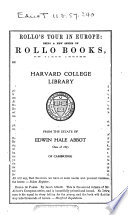 | David Henry Cruttenden - 1853 - 330 páginas
...6. CASE IV. 1. To find the COMMON DIFFERENCE, knowing the Extremes and the Number of terms. 2. RULE. Divide the difference of the extremes by the number of terms less by 1. 3. Thus, the extremes being 8 and 2258, the number of terms being 76 ; what will be the common... | |
 | Thomas Tucker Smiley - 1854 - 192 páginas
...CoteZ. When the first and last terms (or two extremes,) are given to find the common difference. Rule. Divide the difference of the extremes by the number of terms, less 1; the quotient will be the common difference. Questions. Name the five things which should be particularly... | |
 | Benjamin Greenleaf - 1854 - 342 páginas
...the common difference. Thus, 27 -r- 9 = 3, the common difference. Hence the following xj RULE. — Divide the difference of the extremes by the number of terms less one, and the quotient is the common difference. EXAMPLES FOR PRACTICE. 1. The extremes of a series... | |
 | Benjamin Greenleaf - 1854 - 300 páginas
...first term from the last, we have the difference of the extremes ; thus, \ — J=¿And, by dividing the difference of the extremes by the number of terms less 1, we have the common difference, | — (5— l)=2Ji =d. e+A=i; i+A=&¡ -&+A=HThe means, therefore, are... | |
 | Roswell Chamberlain Smith - 1856 - 334 páginas
...thecommon difference. Thus,28 — 3=25; then, 25-=-5=5years, the common difference. A. 5 years. 11. Hence, to find the common difference, — Divide the...extremes by the number of terms, less 1, and the quotient Witt te the common difference. 12. If the extremes be 3 and 23, and the number of terms 11, what is'... | |
 | Charles Guilford Burnham - 1857 - 328 páginas
...When the extremes and number of terms are given, to find the common difference, we have this RULE. Divide the difference of the extremes by the number...1, and the quotient will be the common difference. 7. If the first term of a series be 3, the last term 276, and the number of terms 40, what is the common... | |
 | Charles Guilford Burnham - 1857 - 342 páginas
...of terms are given, to find the common difference, we have this RULE. Divide the difference of tlie extremes by the number of terms less 1, and the quotient will be the common difference. 7. If the first term of a series be 3, the last term 276, and the number of terms 40, what is the common... | |
 | James Stewart Eaton - 1857 - 376 páginas
...PROB. 2. — The extremes and number of terms being given, to find the common difference, RULE. — Divide the difference of the extremes by the number of terms less one, and the quotient will be the common difference. Ex. 1. The extremes of an arithmetical series... | |
 | Benjamin Greenleaf - 1857 - 336 páginas
...be the common difference. Thus, 27 -S- 9 = 3, the common difference. Hence the following RULE. — Divide the difference of the extremes by the number of terms less one, and the quotient is the common difference. EXAMPLES FOR PRACTICE. 1. The extremes of a series... | |
 | Benjamin Greenleaf - 1857 - 452 páginas
...divided by the number of common differences, 21, gives 2 as the common difference required. RULE. — Divide the difference of the extremes by the number of terms less one, and the quotient will be the common difference. EXAMPLES. 2. A certain school consists of 19 teachers... | |
| |